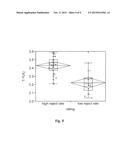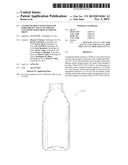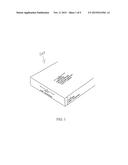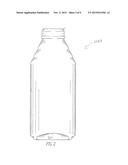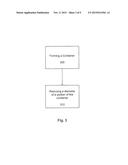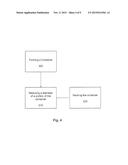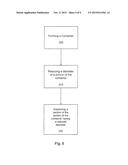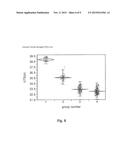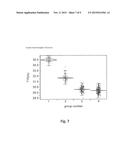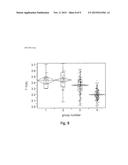Patent application title: ALUMINUM SHEET WITH ENHANCED FORMABILITY AND AN ALUMINUM CONTAINER MADE FROM ALUMINUM SHEET
Inventors:
Thomas N. Rouns (Pittsburgh, PA, US)
David J. Mcneish (Greensburg, PA, US)
Darl G. Boysel (Delmont, PA, US)
Guy P. Wilson (Newburgh, IN, US)
Greg Mrozinski (Newburgh, IN, US)
Jean F. Capps (Owensboro, KY, US)
Neesha A. Ghadiali (Evansville, IN, US)
Samuel Combs (Newburgh, IN, US)
Christopher R. Miller (Newburgh, IN, US)
Robert E. Dick (Cheswick, PA, US)
Robert E. Dick (Cheswick, PA, US)
IPC8 Class: AB21D5102FI
USPC Class:
215374
Class name: Support structure permanently affixed one-piece with the container footed support
Publication date: 2015-11-05
Patent application number: 20150314361
Abstract:
An aluminum sheet comprises a 3XXX or a 5xxx alloy having a tensile yield
strength as measured in the longitudinal direction of 27-33 ksi and an
ultimate tensile strength; wherein the ultimate tensile strength minus
the tensile yield strength is less than 3.30 ksi (UTS-TYS<3.30 ksi).
An aluminum container has a dome, wherein the dome comprises a AA 3XXX or
a 5xxx having a tensile yield strength as measured in the longitudinal
direction of 27-33 ksi and an ultimate tensile strength; wherein the
ultimate tensile strength minus the tensile yield strength is less than
3.30 ksi (UTS-TYS<3.30 ksi).Claims:
1. A device comprising: an aluminum sheet comprising a 3XXX or a 5xxx
alloy having a tensile yield strength as measured in the longitudinal
direction of 27-33 ksi and an ultimate tensile strength; wherein the
ultimate tensile strength minus the tensile yield strength is less than
3.30 ksi (UTS-TYS<3.30 ksi).
2. The device of claim 1 wherein the tensile yield strength as measured in the longitudinal direction of 28-32 ksi.
3. The device of claim 1 wherein the tensile yield strength as measured in the longitudinal direction of 28.53-31.14 ksi.
4. The device of claim 1 wherein the ultimate tensile strength minus the tensile yield strength is 2.90-3.30 ksi.
5. The device of claim 1 wherein the ultimate tensile strength minus the tensile yield strength is 2.99-3.30 ksi.
6. The device of claim 1 wherein the aluminum sheet comprises one of AA: 3x03, 3x04 or 3x05.
7. The device of claim 1 wherein the aluminum sheet comprises AA 3104.
8. A device comprising: an aluminum container having a dome, wherein the dome comprises a AA 3XXX or a 5xxx having a tensile yield strength as measured in the longitudinal direction of 27-33 ksi and an ultimate tensile strength; wherein the ultimate tensile strength minus the tensile yield strength is less than 3.30 ksi (UTS-TYS<3.30 ksi).
9. The device of claim 8 wherein the tensile yield strength as measured in the longitudinal direction of 28-32 ksi.
10. The device of claim 8 wherein the tensile yield strength as measured in the longitudinal direction of 28.53-31.14 ksi.
11. The device of claim 8 wherein the ultimate tensile strength minus the tensile yield strength is 2.90-3.30 ksi.
12. The device of claim 8 wherein the ultimate tensile strength minus the tensile yield strength is 2.99-3.30 ksi.
13. The device of claim 8 wherein the aluminum sheet comprises one of AA: 3x03, 3x04 or 3x05.
14. The device of claim 8 wherein the aluminum sheet comprises AA 3104.
15. The device of claim 8 wherein the aluminum container is a bottle.
16. A method comprising: forming a container from an aluminum sheet comprising a 3XXX or a 5xxx alloy having a tensile yield strength as measured in the longitudinal direction of 27-33 ksi and an ultimate tensile strength; wherein the ultimate tensile strength minus the tensile yield strength is less than 3.30 ksi (UTS-TYS<3.30 ksi); and reducing a diameter of a portion of the container by at least 26%.
17. The method of claim 16 wherein reducing a diameter of the container by at least 26% comprises necking the container with necking dies.
18. The method of claim 17 reducing the diameter of the container by at least 26% comprises necking the container at least 14 times.
19. The method of claim 16 wherein the diameter of the container is reduced by at least 30%.
20. The method of claim 16 wherein the tensile yield strength as measured in the longitudinal direction of 28-32 ksi.
21. The method of claim 16 wherein the tensile yield strength as measured in the longitudinal direction of 28.53-31.14 ksi.
22. The method of claim 16 wherein the ultimate tensile strength; wherein the ultimate tensile strength minus the tensile yield strength is 2.90-3.30 ksi.
23. The method of claim 16 wherein the ultimate tensile strength; wherein the ultimate tensile strength minus the tensile yield strength is 2.99-3.30 ksi.
24. The method of claim 16 wherein the aluminum sheet comprises one of AA: 3x03, 3x04 or 3x05.
25. The method of claim 16 wherein the aluminum sheet comprises AA 3104.
26. The method of claim 16 wherein the container is a bottle.
27. The method of claim 16 further comprising expanding a section of the portion of the container having a reduced diameter.
28. The method of claim 27 wherein the section has a length and the length is at least 0.3 inches.
29. The method of claim 28 wherein the length is at least 0.4 inches.
Description:
CROSS-REFERENCE TO RELATED APPLICATIONS
[0001] This patent application claims priority to U.S. Provisional Patent Application No. 61/986,692 filed Apr. 30, 2014, which is incorporated herein by reference in its entirety.
BACKGROUND
[0002] In the container industry, substantially identically shaped metal beverage containers are produced massively and relatively economically. In order to expand a diameter of a container to create a shaped container or enlarge the diameter of the entire container, often several operations are required using several different expansion dies to expand each metal container a desired amount. Also, dies have been used to neck and shape the containers. Often several operations are required using several different necking dies to narrow each metal container a desired amount. Open ends of containers are formed by flanging, curling, threading and/or other operations to accept closures. Necking, expanding, shaping, and finishing operations sometimes cause metal failures, such as one or more of the following: curl splits, container fracture, container collapse.
SUMMARY
[0003] Referring to FIG. 1, an aluminum sheet 100 comprises a AA 3XXX or a 5xxx alloy having a tensile yield strength (TYS) as measured in the longitudinal direction of 27-33 ksi and an ultimate tensile strength (UTS); wherein the ultimate tensile strength minus the tensile yield strength is less than 3.30 ksi (UTS-TYS<3.30 ksi). In some embodiments, the tensile yield strength as measured in the longitudinal direction is 28-32 ksi. In some embodiments, the tensile yield strength as measured in the longitudinal direction is 28.53-31.14 ksi. In some embodiments, the ultimate tensile strength minus the tensile yield strength is 2.90-3.30 ksi. In some embodiments, the ultimate tensile strength minus the tensile yield strength is 2.99-3.30 ksi. In some embodiments, the aluminum sheet comprises one of AA: 3x03, 3x04 or 3x05. In some embodiments, the aluminum sheet comprises AA 3104. In some embodiments, the aluminum sheet comprises AA 5043. In some embodiments, the ultimate tensile strength is 30-36 ksi. In some embodiments, the ultimate tensile strength is 31-35 ksi. In some embodiments, the ultimate tensile strength is 31.51-34.51 ksi.
[0004] In some embodiments, the TYS and (UTS-TYS) values described above are for an aluminum sheet coil "as shipped" to a can maker. The container forming process performed by the can maker includes thermal treatments and mechanical processes, i.e. cold working, both of which affect the TYS and (UTS-TYS) values. The TYS and (UTS-TYS) values of a particular container will vary depending on the thermal treatments and mechanical processes used to form the container and the TYS and (UTS-TYS) values will vary along various points on a single container. For example, sidewalls of a container generally have a lot of cold work, which will result in higher TYS. Heat treatments generally lower TYS. The dome of a container will experience heat treatments but little cold work so the TYS of the dome of a formed container made with sheet described above may be slightly lower than the TYS of the sheet described above.
[0005] Referring to FIG. 2, an aluminum container 200 has a dome 210, wherein the dome 210 comprises a AA 3XXX or a 5XXX alloy having a tensile yield strength as measured in the longitudinal direction of 27-33 ksi and an ultimate tensile strength; wherein the ultimate tensile strength minus the tensile yield strength is less than 3.30 ksi (UTS-TYS<3.30 ksi). In some embodiments, the tensile yield strength as measured in the longitudinal direction is 28-32 ksi. In some embodiments, the tensile yield strength as measured in the longitudinal direction is 28.53-31.14 ksi. In some embodiments, the ultimate tensile strength minus the tensile yield strength is 2.90-3.30 ksi. In some embodiments, the ultimate tensile strength minus the tensile yield strength is 2.99-3.30 ksi. In some embodiments, dome 210 comprises one of AA: 3x03, 3x04 or 3x05. In some embodiments, the dome 210 comprises AA 3104. In some embodiments, the dome 210 comprises AA 5043. In some embodiments, the ultimate tensile strength is 30-36 ksi. In some embodiments, the ultimate tensile strength is 31-35 ksi. In some embodiments, the ultimate tensile strength is 31.51-34.51 ksi. In some embodiments, the aluminum container is a bottle. In some embodiments, the aluminum container has been formed by drawing and ironing an aluminum sheet.
[0006] Referring to FIG. 3, a method comprises: forming a container 300 from an aluminum sheet comprising a 3XXX or a 5xxx alloy having a tensile yield strength as measured in the longitudinal direction of 27-33 ksi and an ultimate tensile strength; wherein the ultimate tensile strength minus the tensile yield strength is less than 3.30 ksi (UTS-TYS<3.30 ksi); and reducing a diameter of a portion of the container 310 by at least 26%.
[0007] Referring to FIG. 4, in some embodiments, reducing a diameter of the container 310 by at least 26% comprises necking the container 320 with necking dies. In some embodiments, reducing the diameter of the container 310 by at least 26% comprises necking the container 320 at least 14 times. In some embodiments, the diameter of the container is reduced by at least 30%.
[0008] In some embodiments, the tensile yield strength as measured in the longitudinal direction is 28-32 ksi. In some embodiments, the tensile yield strength as measured in the longitudinal direction is 28.53-31.14 ksi. In some embodiments, the ultimate tensile strength minus the tensile yield strength is 2.90-3.30 ksi. In some embodiments, the ultimate tensile strength minus the tensile yield strength is 2.99-3.30 ksi. In some embodiments, the aluminum sheet comprises one of AA: 3x03, 3x04 or 3x05. In some embodiments, the aluminum sheet comprises AA 3104. In some embodiments, the aluminum sheet comprises AA 5043. In some embodiments, the ultimate tensile strength is 30-36 ksi. In some embodiments, the ultimate tensile strength is 31-35 ksi. In some embodiments, the ultimate tensile strength is 31.51-34.51 ksi.
[0009] In some embodiments, the container is a bottle.
[0010] Referring to FIG. 5, in some embodiments, the method further comprises expanding a section of the portion of the container having a reduced diameter 330. In some embodiments, the section has a length and the length is at least 0.3 inches. In some embodiments, the length is at least 0.4 inches.
[0011] An aluminum sheet is rolled aluminum having a thickness of 0.006 inch to 0.030 inch.
[0012] A dome is the dome at the bottom of the container.
[0013] A bottle is a rigid container having a neck that is narrower than the body.
[0014] The tensile yield strength is defined as the load at 0.2% offset yield divided by the original cross sectional area of the specimen. The ultimate tensile strength is the maximum load divided by the original cross sectional area.
[0015] The alloys and tempers mentioned herein are as defined by the American National Standard Alloy and Temper Designation System for Aluminum ANSI H35.1 and "the Aluminum Association International Alloy Designations and Chemical Composition Limits for Wrought Aluminum and Wrought Aluminum Alloys as revised February 2009.
BRIEF DESCRIPTION OF THE DRAWINGS
[0016] FIG. 1 is a partial enlarged perspective view of an aluminum sheet;
[0017] FIG. 2 is a side view of an aluminum bottle having a dome;
[0018] FIG. 3 depicts process steps according to one embodiment;
[0019] FIG. 4 depicts process steps according to another embodiment;
[0020] FIG. 5 depicts process steps according to a further embodiment;
[0021] FIG. 6 is a graph illustrating the UTS of groups of coils 1-4;
[0022] FIG. 7 is a graph illustrating the TYS of groups of coils 1-4;
[0023] FIG. 8 is a graph illustrating the UTS-TYS of groups of coils 1-4; and
[0024] FIG. 9 plots low and high reject rate coils verses UTS-TYS.
DESCRIPTION
[0025] The formability of can bottle stock (as measured by reject rate after finishing the opening of the container) has been empirically demonstrated to increase with reduced (<3.30 ksi) UTS-TYS difference. UTS-TYS differences of <3.30 ksi have resulted in less product rejects. Specimens measured were made from finished gauge sheet with a nominal width of ˜0.50''. The samples were oriented such that the rolling direction is parallel to the applied load.
[0026] In some embodiments, finishing comprises one or a combination of the following: forming threads, expanding, narrowing, curling, flanging, or forming the opening of the container to accept a closure. Bottles made from coils of aluminum sheet with UTS-TYS<3.30 ksi have lower reject rates after finishing. Rejection can be caused by container failures, such as one or more of the following: curl splits, container fracture, container collapse. Other types of container failures may cause rejection.
[0027] One method to produce reduced UTS-TYS difference bottle stock sheet is a reduction in Ti level and an increase in preheat soak time from standard production targets. In some embodiments, the Ti levels in the aluminum sheet are in the range of 0.0030-0.008 wt %. In some embodiments, the aluminum sheet experiences presoak times in the range of 3 hours at 1080° F. plus 30-40 hours at 1060° F. In some embodiments, the aluminum sheet experiences presoak times in the range of 3 hours at 1080° F. plus 35-40 hours at 1060° F. In some embodiments, the aluminum sheet experiences presoak times in the range of 3 hours at 1080° F. plus 37-40 hours at 1060° F.
[0028] Aluminum sheet (10 coils) having an average TYS of ˜35.35 ksi (range 34.38-36.18 ksi) with UTS-TYS average of 3.47 ksi (range 3.30-3.80 ksi) are in group 1. The average UTS of group 1 was 38.89 ksi (range 38.09-39.49 ksi). The material in group 1 lacked sufficient formability to be used in the manufacture of bottles.
[0029] Coils of aluminum sheets having an average TYS of 32.15 ksi (range 31.00-34.16 ksi) with an average UTS-TYS of 3.42 ksi (range 3.08-3.72 ksi) are in group 2. The average UTS of group 2 was 35.57 ksi (range 34.34-37.49 ksi). The material in group 2 lacked sufficient formability to be used in the manufacture of bottles.
[0030] Group 3 coils of aluminum sheet had an average TYS of 30.06 ksi (range 28.97-31.23 ksi) and an average UTS-TYS of 3.36 ksi (range 3.02-3.64 ksi). The average UTS of group 3 was 33.41 ksi (range 31.65-34.81 ksi). Of the group 3 coils some were identified as performing with low bottle reject rates after finishing. Some has sufficient formability to be used in the manufacture of bottles.
[0031] Coils of aluminum sheet having an average TYS of 29.83 ksi (28.53-31.14 ksi) and an average UTS-TYS of 3.20 ksi (2.99-3.43 ksi) fall in group 4. The average UTS of group 4 was 33.03 ksi (range 31.54-34.51 ksi). Bottles made from coils of aluminum sheet in group 4 with UTS-TYS<3.30 ksi have low reject rates after finishing.
[0032] The UTS of groups 1-4 is shown in the graph in FIG. 6. The TYS of groups 1-4 is shown in the graph in FIG. 7. The UTS-TYI of groups 1-4 is shown in the graph in FIG. 8.
[0033] The UTS-TYS of a subset of coils from group 3 is plotted against reject rates in FIG. 9. As can be seen in FIG. 9, there is a statistically significant difference in the UTS-TYS for known high reject rate coils and low reject rate coils.
[0034] A partition analysis on the reject rate can split the lots into two groups that have the minimal misclassification error at a UTS-TYS value of 3.3. The table below shows the results of the partition analysis of the same data set included in FIG. 9.
TABLE-US-00001 UTS-TYS < 3.3 UTS-TYS >= 3.3 low reject rate lots 16 2 high reject rate lots 4 21
[0035] The rate at which the material work hardens is also critical to form a bottle with lower reject rates. Flow stress for aluminum is often defined by a Voce Equation (σ=A-Bexp(-Cε)) in which the strain hardening rate is defined by the coefficient "C". Investigation of C values between 5 and 25 resulted in significant bottle forming differences. In some embodiments, a C value in the range of 12-18 can be used to minimize reject rates. In other embodiments a C value in the range of 15-25 can be used. In other embodiments a C value in the range of 20-35 can be used. In other embodiments a C value in the range of 25-50 can be used. In other embodiments a C value in the range of 5-12 can be used.
[0036] While various embodiments of the present disclosure have been described in detail, it is apparent that modifications and adaptations of those embodiments will occur to those skilled in the art. However, it is to be expressly understood that such modifications and adaptations are within the spirit and scope of the present disclosure.
User Contributions:
Comment about this patent or add new information about this topic:

